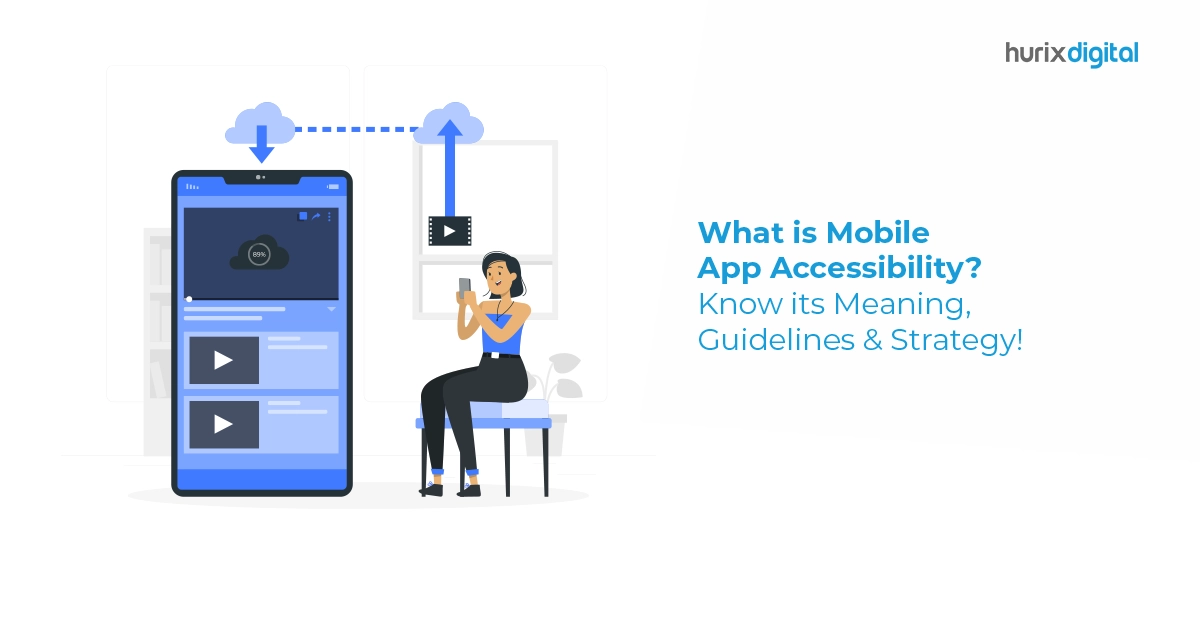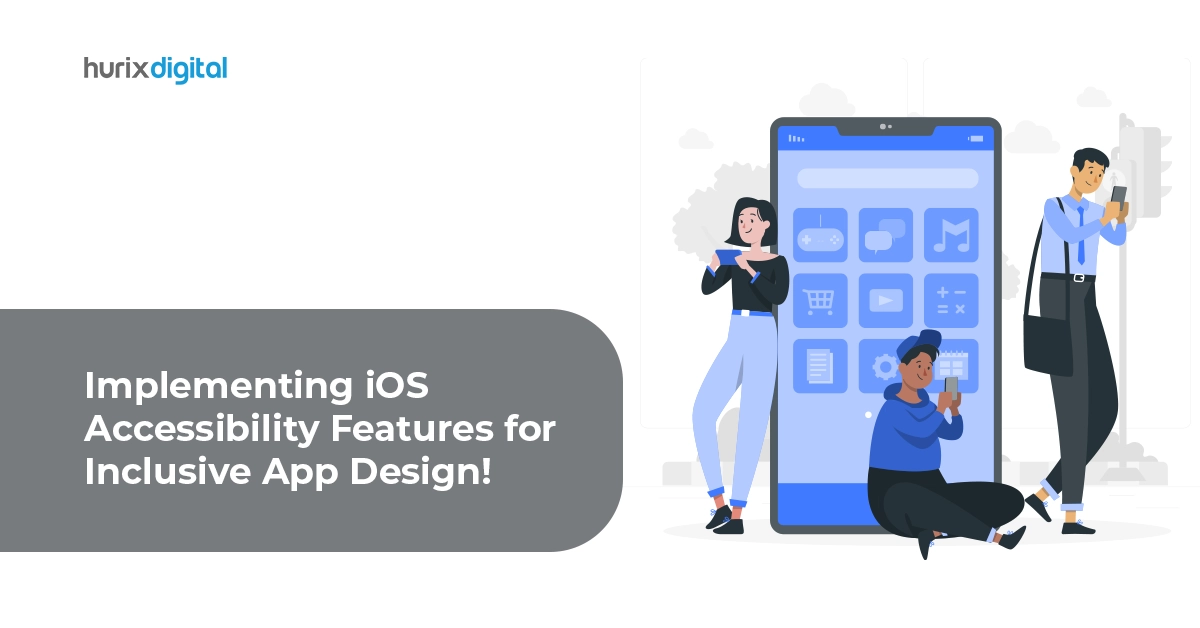Summary
This blog provides you with the necessary knowledge to create an accessible mobile experience for your business.
Mobile devices are everywhere, and it will come as no surprise that the number of active mobile users worldwide is around 4.97 billion as of 2022. This is estimated to be 60% of the global internet population. This vast audience uses mobile devices for daily activities like accessing the internet, consuming content, and more.
If your app or platform is not mobile-optimized, you are likely missing out on a huge target group. An average user spent 5.19 hours daily on their smartphones in 2022, and 42.4% of this time is spent on mobile apps, only second to social media and communication platforms. Thus, most of your users will likely interact with your business on a mobile app instead of traditional mediums like a website.
In this digital age, mobile app accessibility is an integral feature that any digital product must have. This is irrespective of what it does or the target audience for the platform. As per WCAG guidelines, mobile applications must be inclusive and user-friendly for all individuals, regardless of their abilities.
Keep reading to know more about mobile app accessibility, its myriad benefits, and how it plays a role in accessibility and design.
Table of Contents:
- What Is Mobile App Accessibility?
- Challenges in Designing a Mobile Accessible App
- Benefits of Mobile App Accessibility
- How to Design Mobile Apps that Are Highly Accessible?
- Wrapping Up
What Is Mobile App Accessibility?
Mobile App Accessibility is a set of protocols that application designers and developers must abide by to ensure that their apps are easy to use and accessible to all, even those with disabilities. From using a screen reader to voice commands to interact with an app, adding alternative or additional usability can ensure that all users can make the most of your mobile application.
Mobile accessibility standards are often set and updated by several bodies and expert accessibility consultations, considering the unique needs of various individuals. This helps ensure that even people with disabilities, including visual, auditory, motor, or cognitive, can easily use and interact with your application.
The goal of this entire exercise is to make digital content more accessible to all, regardless of their physical or cognitive limitations.
Challenges in Designing a Mobile Accessible App
Creating a mobile application is not rocket science, and many app developers can help you build a well-functioning app in a matter of days. However, just having an app is not enough.
Today, most businesses must manage multiple platforms and interaction channels, wherein mobile app accessibility is crucial.
This can be challenging to most due to factors such as:
1. Budget Constraints
Implementing mobile app accessibility features is crucial but requires time, resources, and costs. This added cost can play a role in most companies skipping it altogether.
However, the investment in accessibility is a strategic one. Organizations should consider the return on investment and not just consider it a legal compliance measure. By viewing accessibility as a long-term investment, businesses can improve user experience and, thereby, revenue, making it viable for business success.
2. Lack of Awareness
One of the primary challenges businesses face is the lack of awareness about the importance of mobile app accessibility. Decision-makers may not fully understand the potential impact on user engagement and the bottom line. To overcome this, businesses must prioritize education and training for their teams.
Also Read: What is Mobile Accessibility? Understanding its Benefits & Importance
Benefits of Mobile App Accessibility
Being mobile-friendly doesn’t just help your application or website reach a sizeable audience; it has several other benefits, including the following:
1. Inclusivity
By designing apps that accommodate individuals with disabilities, you extend your reach to a larger user base, fostering a sense of belonging and equality. Since 1.3 billion people live with some form of disability, ensuring that your mobile app is easily accessible makes a significant impact in creating inclusive content.
2. Legal Compliance
Mobile app accessibility is also a norm per several regulatory requirements, including Web Content Accessibility Guidelines (WCAG), Americans with Disabilities Act (ADA), and other regulations. Several regions can have their legal requirements for digital accessibility.
By complying with these regulations, your app can avoid any legal issues while enhancing your brand’s reputation.
3. Improved User Experience
Accessibility features don’t just help one section of the audience but benefit everyone. For example, captions and transcripts benefit not only people who are hard of hearing but also users who may be watching a video in a noisy environment.
4. Improved Visibility
Websites and apps that follow mobile app accessibility standards often get increased reach and improved ranking, be it search engines or the App Store. As more users engage and interact with your application, search engines, and app stores will likely promote your app over your competition, ensuring you have better visibility.
5. Greater Revenue Opportunities
Mobile accessibility ensures that your content can be viewed on several devices and platforms, ensuring that people of all ages and requirements can use it. Therefore, you can reach a wider audience base and improve the likelihood of users trusting your brand. Consequently, you will generate additional revenue and profit while ensuring higher customer satisfaction and improved retention.
How to Design Mobile Apps that Are Highly Accessible?
Ready to design a highly mobile-optimized app? While there are comprehensive mobile app accessibility testing checklists, here are a few simple steps that you can follow to be mobile-ready:
- Start by understanding the needs of your target audience, including individuals with disabilities. Work on user personas with various accessibility requirements to help guide your design process.
- Adhere to established accessibility guidelines such as the Web Content Accessibility Guidelines (WCAG) to ensure your app meets industry standards. These guidelines cover various considerations, from color contrast to keyboard navigation.
- Include alternative text for images, icons, and other non-text content. Screen readers rely on this information to describe visual elements to users with visual impairments.
- Include captions for videos and transcripts for audio content to make your app more accessible to individuals with hearing impairments.
- Regularly test your app and take feedback from your users, especially those with accessibility issues. Their feedback can go a long way in crafting accessible and user-friendly content.
- Pay attention to the cognitive aspects of accessibility, such as clear and concise content, consistent navigation, and avoiding overwhelming users with complex interfaces.
- Keep your app updated and address accessibility issues promptly. Technology evolves, and so do accessibility standards and best practices.
Also Read: The Only Checklist You Need For Mobile App And Web Accessibility Testing
Wrapping Up
Mobile app accessibility is not just a legal obligation; it’s a moral imperative and an intelligent business move. It ensures inclusivity and compliance with legal regulations, enhances the user experience, opens new business opportunities, and improves your app’s discoverability.
By following mobile app accessibility guidelines and considering the diverse needs of your users, you can create mobile apps that positively impact people’s lives while benefiting your business.
If you need help understanding the mobile accessibility standards for effective design, contact our experts at Hurix Digital. Our team of consultants and accessibility experts can help you create apps that are accessible to all. Get in touch with us now!







